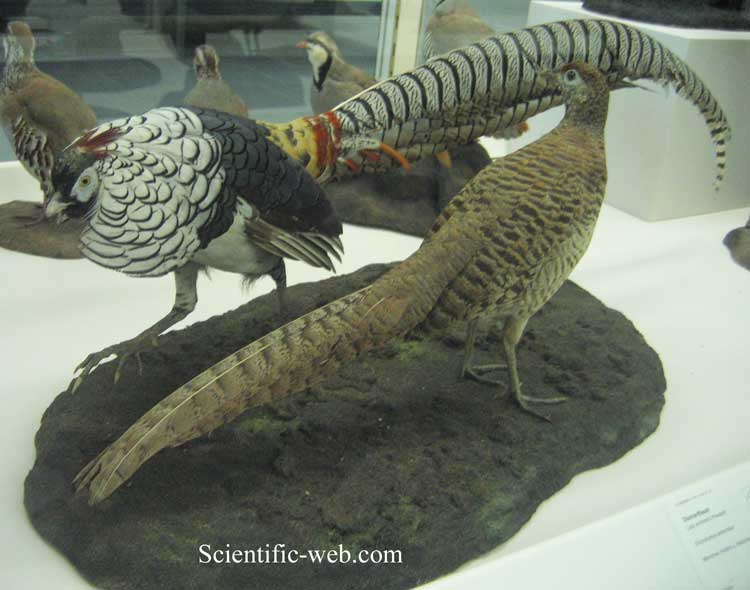
Chrysolophus amherstiae, Photo: Michael Lahanas
Superregnum: Eukaryota
Regnum: Animalia
Subregnum: Eumetazoa
Cladus: Bilateria
Cladus: Nephrozoa
Superphylum: Deuterostomia
Phylum: Chordata
Cladus: Craniata
Subphylum: Vertebrata
Infraphylum: Gnathostomata
Superclassis: Tetrapoda
Cladus: Reptiliomorpha
Cladus: Amniota
Classis: Reptilia
Cladus: Eureptilia
Cladus: Romeriida
Subclassis: Diapsida
Cladus: Sauria
Infraclassis: Archosauromorpha
Cladus: Crurotarsi
Divisio: Archosauria
Subsectio: Ornithodira
Subtaxon: Dinosauromorpha
Cladus: Dinosauria
Ordo: Saurischia
Cladus: Theropoda
Cladus: Neotheropoda
Infraclassis: Aves
Cladus: Euavialae
Cladus: Avebrevicauda
Cladus: Pygostylia
Cladus: Ornithothoraces
Cladus: Euornithes
Cladus: Ornithuromorpha
Cladus: Ornithurae
Cladus: Carinatae
Parvclassis: Neornithes
Cohors: Neognathae
Cladus: Galloanseres
Ordo: Galliformes
Familia: Phasianidae
Subfamilia: Phasianinae
Genus: Chrysolophus
Species: Chrysolophus amherstiae
Name
Chrysolophus amherstiae (Leadbeater, 1829)
Synonymy
Phasianus amherstiae (protonym)
Lady Amherst's pheasant. Chrysolophus amherstiae, Joseph Wolf
References
Transactions of the Linnean Society of London 16: 129, t.15.
Vernacular names
čeština: Bažant diamantový
Deutsch: Amherstfasan
English: Lady Amherst's Pheasant
Esperanto: Diamanta fazano
magyar: Gyémántfácán
日本語: ギンケイ
한국어: 은계
polski: Bażant diamentowy
русский: Алмазный фазан
中文: 白腹锦鸡
Lady Amherst's pheasant (Chrysolophus amherstiae) is a bird of the order Galliformes and the family Phasianidae. The genus name is from Ancient Greek khrusolophos, "with golden crest". The English name and amherstiae commemorates Sarah Amherst, who was responsible for sending the first specimen of the bird to London in 1828.[2] Lady Amherst's pheasant is evaluated as Least Concern on the IUCN Red List of Threatened Species.
Distribution and habitat
The species is native to southwestern China and far northern Myanmar, but has been introduced elsewhere. Previously, a self-supporting feral population was established in England, the stronghold of which was in West Bedfordshire. Lady Amherst first introduced the ornamental pheasant on her estates, near the Duke of Bedford's Woburn Abbey, where the birds were also shot for game and interbred.[3] Although thought to have been eradicated in Great Britain since 2015, a Lady Amherst's pheasant was photographed in Staplegrove, Taunton, May 2020. Subsequently, in early March 2021, a Lady Amherst's pheasant was spotted in a garden in Scotland.[4]
Description
The adult male is 100–120 cm (40-48 in.) in length, its tail accounting for 80 cm (31 in) of the total length. It is unmistakable with its nuchal cape white black, with a red crest. The long grey tail and rump is red, blue, dark green, white and yellow plumage. The "cape" can be raised in display. This species is closely related to the golden pheasant (C. pictus), but has a yellow eye, blue-green bare skin around it. The bill is horn-coloured and they had blue-gray legs.[5]
The female is much less showy, with a duller mottled brown plumage all over, similar to that of the female common pheasant (P. colchicus) but with finer barring. She is very like the female golden pheasant, but has a darker head and cleaner underparts than the hen of that species.
Despite the male's showy appearance, these birds are very difficult to see in their natural habitat, which is dense, dark forests with thick undergrowth. Consequently, little is known of their behaviour in the wild.
Diet and behaviour
They feed on the ground on grain, leaves and invertebrates, but roost in trees at night. Whilst they can fly, they prefer to run, but if startled they can suddenly burst upwards at great speed, with a distinctive wing sound. The male emits a metallic call in the breeding season.
Lady Amherst's x golden pheasant cross. In a pure Lady Amherst's pheasant, the red crest starts roughly halfway between the cere to the crest tip (not at the beak), and the belly would be all white without any red or brown tainting.
Hybrid male
References
BirdLife International (2012). "Chrysolophus amherstiae". IUCN Red List of Threatened Species. 2012. Retrieved 26 November 2013.
Jobling, James A (2010). The Helm Dictionary of Scientific Bird Names. London: Christopher Helm. pp. 45, 105. ISBN 978-1-4081-2501-4.
Fitter, p.86
"Colorful Bird Thought to be Extinct in the UK Captured on Video Walking About in Scotland!".
Fitter, p.86
Bibliography
Briggs, M.; Briggs, P. (2009). The Natural History of the British Isles. Bath, UK.
Fitter, R.S.R. (1955) [1952]. The Pocket Guide of British Birds. London: Collins.
Peter Scott (1969). Book of British Birds. London.
Retrieved from "http://en.wikipedia.org/"
All text is available under the terms of the GNU Free Documentation License


